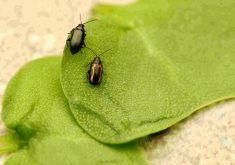The Canola Council of Canada flags several verticillium signs:
Stem striping
When the crop is full height, but still green, infected canola plants will often have a two-toned stem — half healthy and green and half discoloured and drying down. This is where the disease gets its name.
Read Also

Still hard to predict precise fertilizer payback
Despite decades of advances, international research finds no clear answer for where and when adding nutrient will fail to boost growth.
Leaves can show similar symptoms: healthy on one side, diseased on the other.
This is one way to differentiate verticillium stripe, since farmers will not see stem or leaf striping with blackleg or sclerotinia stem rot. Sclerotinia will cause stem discolouration but it will not stripe half the stem.

Stem cross-section discolouration
Verticillium stripe infects roots and enters the plant’s vascular system. Verticillium hyphae (branching filaments that make up the mycelium of a fungus) and conidia (asexual spores) fill up the vascular system, giving the stem cross-section a greyish colour.
This is easily confused with blackleg. There are two main tips to distinguish the pathogens. With blackleg, stem tissue infections tend to be darker and cause distinct wedge shapes of black. Verticillium is lighter grey and more general throughout the cross-section.
Blackleg stem discolouration is confined to the crown area at the base of the stem. Verticillium darkening can extend well up the stem.
Black specks
As the verticillium infection advances, microsclerotia will start to form on the underside of the peeling stem skin. These can be found all the way up the stem.
Verticillium specks may seem similar to blackleg pycnidia, but they’re much smaller – more like powdery pepper. In some cases, blackleg pycnidia will have a purple-pinkish ooze of pycnidiospores around them. Blackleg pycnidia are also confined to a lesion no more than a few centimetres in size. If you see pink and specks confined to a lesion, it’s blackleg.

Stem peeling and weakening
Peeling stem skin is a symptom of verticillium stripe. Under that peeled outer layer will be the microsclerotia, often taking the shape of faint black vertical striping.
Severely diseased stems may break off and can be confused with lodging.

Sclerotinia stem rot will also cause weakened, brittle stems, but sclerotinia will not have the stripy, speckly microsclerotia. Sclerotinia stem rot will cause the entire stem tissue to shred, not just the outer layer.
Inside the stem, sclerotinia will form sclerotia bodies – the canola-seed-sized resting bodies. Verticillium stripe does not produce sclerotia bodies.















